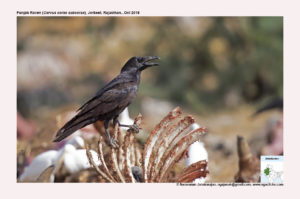Punjab Raven

Punjab Raven Corvus corax subcorax
Etymology:
- Corvus : Latin Word for Raven
- Corax : Greek Word Raven
- Subcorax : Latin word sub- Near ; corax –raven { Like Raven}
Distribution in India: Resident of North West of India.
Description: Size of 58–69 cm; wt. of 585–2000 g; wingspan of 120–150 cm. It is the largest corvid with large, powerful bill with nasal bristles covering half or less of exposed culmen, long throat feathers and lanceolate (especially on male) and erected during dominance displays. In flight, it has long, fairly broad wings with prominent fingers, especially long tail often spread to form diamond shape. The nominate race is black, with greenish gloss on head and tail, primaries and underparts, more bluish-purple gloss on upperparts and rest of wing. The bases of neck feathers are brownish-grey; plumage is generally duller and browner, with less gloss, when worn; iris is dark brown; bill and legs are black. Both the sexes are similar, the male significantly larger than female. The juvenile is duller than adult, with less metallic sheen, lacks lanceolate throat plumes, has iris as light blue, soon becoming grey; immature has wing and tail feathers as dull and brownish; base of bill gradually turns from yellowish to black during first year, and tongue, gape and palate turn from red to mottled grey/black to fully black during first two years, depending on social status. The dominant birds attain black mouth lining within 1 year, but subordinates may not obtain black lining for several years.
Habitat: It is found in extreme habitats, breeding throughout forested and open coastal, steppe, mountain, desert and tundra and cliff regions of Northern Hemisphere.
Food Habits: It is an opportunistic scavenger, closely associated with large carnivores, most notably wolves, and wasteful omnivores, notably humans. It eats huge variety of animals and plants. Preys on adult and nestling birds, eggs, small mammals, sick and dying larger mammals, toads, snakes, juvenile turtles, fish, and consumes invertebrates, Orthoptera, Lepidoptera, Coleoptera, craneflies , ants, slugs, scorpions, earthworms, snails and diversity of marine invertebrates. It scavenges garbage and slaughterhouse offal, dung, and nearly any kind of carrion, including sheep and cow placentas, discarded entrails of hunted animals, dead fish and whales, and road-killed mammals, birds and reptiles. It eats plant matter like fruits, grains, berries, buds, and calcareous seaweed .Predatory behaviour may result in significant local reductions in nesting success of colonial-nesting birds, also rare species such as desert tortoise. It locates food by sight, sound, also by olfaction at very close distances. Actively scans for carrion, investigates locations of gunshots, wolf howls, and calling conspecifics, watches foraging birds and mammals for cues; actively hunts from perch, in flight and on foot. Where large animal carcasses are a primary food, and when carcasses especially widely dispersed and ephemeral like in snowy regions, naive ravens follow roost mates over many kilometres to newly discovered food bonanzas. Often roosts communally very close to semi-permanent food resources like rubbish dumps, residences offering continuous food supplements. The wandering non-breeders are the most frequent participants in winter roosts, and hence most apt to co-operate in sharing of information regarding food and other resources, these temporary groups of mostly unrelated and often different birds benefiting from sharing information because of increased food encounter rates and increased ability to procure foods defended by dominant breeding pairs. Breeding pairs often defend food discovered on their territory from single wanderers or small groups. It caches a variety of foods, mostly on ground, at all times of the year; caching may be triggered by ephemeral or contested foods. The eggs may be cached as a whole and placed in micro-sites suitable for long-term storage; large or scattered items may be prepared away from cache site to reduce transportation costs like strips of meat and individual crackers collected to make a single load, which then carried to cache site. It combats cache raiders by sneaking out of view to cache, making false caches, and moving caches from locations perceived to be known to others.
Breeding Habits: They breed early in the year when snow often blankets the ground. They are socially monogamous, with lifelong pair-bond. They defend their territory vigorously; the defence involves vigorous chases of intruders accompanied by loud vocalizations, and physical attack with bill and feet if intruder caught. Both the sexes procure nest material, but female appears to do most of construction work, especially shaping nest bowl. The nest construction takes 1–3 weeks. The nest is a large and bulky platform made from dead sticks, lined with fine roots, grass, string and other bits of rubbish, and with mammal fur ,placed in stout, lower branches of tree or more above ground on upper third of steep cliff protected beneath overhanging block or ledge, in crack or in small cave. Sometimes old nest are refurbished and reused. They lay a clutch of 1–8 eggs. The incubation is by female, male occasionally assisting. The incubation period is 20–25 days. The hatching is asynchronous and the chicks are brooded and fed by both parents. The nestling period is 4–7 weeks. The fledglings remain with parents for a few weeks to several months; typically leave natal territory by late summer.